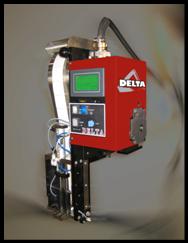Product manufacturers require labeling systems that print product labels onto a diverse range of objects. These need to stick to packaging and products that come in multiple shapes and sizes, with the varied types of industrial labeling systems each meeting specific needs.
Nine Types of Industrial Labeling Systems
In order to efficiently and quickly label products, each of these types of industrial labeling systems is designed to put labels on certain shapes and surfaces. These systems include:
- Conical or tapered systems come in automatic or semi-automatic varieties, and help print labels onto cone-shaped or tapered containers or products. These include labeling variously sized containers, which allow for differing speed options, attaching multiple labels and product taper.
- Flag labeling systems come as either automatic or semi-automatic machines that help adhere labels completely around irregularly shaped products. Commonly used with wirelike or tubelike products, it attaches labels to products that are too small to fit all the labelling information on them.
- Horizontal roller systems automatically label by using horizontally positioned rollers that either move conveyors continuously, in spurts, or in a hybrid manner. These systems are used for products with smaller diameters.
- Multi-side labeling systems are made to work automatically or semi-automatically, often with decorative labels that wrap around rectangular, squarish or other oddly shaped products. These often require machinery custom-made specifically for the product.
- Product encapsulating systems work automatically, using a technique to apply labels to both cylindrical and conical shapes while securing products in a three-roller mechanism, which rotates and applies labels in one fluid motion. It’s used to wrap labels on products with cylindrical-shaped packaging, and helps ensure labels are placed accurately.
- Tamp and wipe industrial labeling systems are used on automatic or semi-automatic lines, and help decrease or eliminate air bubbles and wrinkles in packaging on irregularly shaped surfaces. They do so by either wiping the label onto the product or shuttling the tamp head.
- Top and bottom industrial labeling systems automatically and simultaneously apply labels to both the top and bottoms of products, c-wrapping labels around the product or just label the bottom. They come in three styles, using interrupted, hugger or split belt assemblies, with the type dependent upon how the product’s contact surface relates to the bottom label.
- Vacuum belt wrap systems provide both speed and versatility, working automatically on assembly lines to feed labels onto a vacuum belt that then wraps each product. Used to label a variety of cone-shaped or cylindrical products, they can be customized to attach semi-circular or straight labels, by applying single wraps or labeling both front and back simultaneously.
- Vertical trunnion industrial labeling systems automatically label cylindrically shaped products. With products placed in an upright position, they apply labels rapidly and accurately, and are commonly used to label bottles on high volume production lines.
EAM Models
EAM carries three types of industrial labeling systems, each incorporating web drives that allow them to cope with high-speed assembly lines:
Delta Tag

Mini ST-300
This compact system can be positioned almost anywhere, even in hard-to-reach locations. It applies anti-theft tags using a Programmable Logic Controller (PLC), so no external control enclosure or umbilical cord is needed.
FG-24
Used for applying anti-theft tags, this system allows for speed adjustment, tagging position and skipping via touchscreen. It also compensates for speed to improve the accuracy of tag placement with the help of optional line-speed encoders.
To learn more about these different types of industrial labeling systems and specifically about EAM’s models, contact us directly. EAM offers products for lease and rental, along with 24-hour emergency support.
